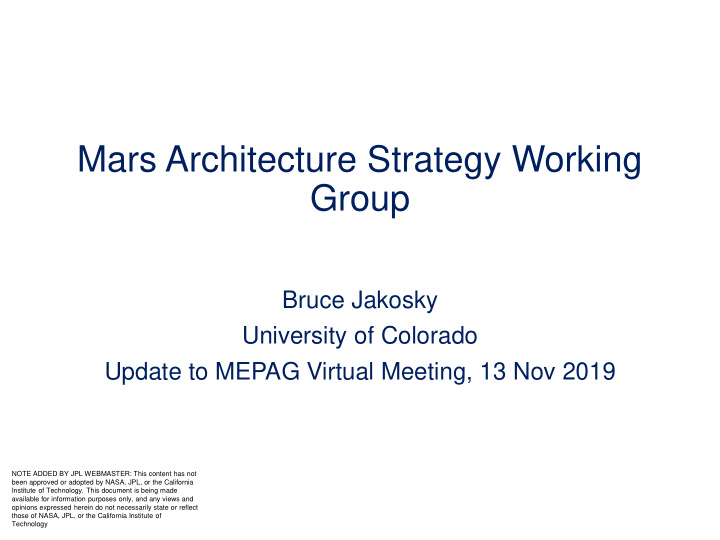



Mars Architecture Strategy Working Group Bruce Jakosky University of Colorado Update to MEPAG Virtual Meeting, 13 Nov 2019 NOTE ADDED BY JPL WEBMASTER: This content has not been approved or adopted by NASA, JPL, or the California Institute of Technology. This document is being made available for information purposes only, and any views and opinions expressed herein do not necessarily state or reflect those of NASA, JPL, or the California Institute of Technology
Why Does This Group Exist? • Triggered by the planetary mid-decadal evaluation committee (co-chaired by Louise Proctor and Joe Rothenberg) • Asked to evaluate Mars program at the same time as it evaluated progress on the Decadal • Recommended that “NASA should develop a comprehensive Mars Exploration Program (MEP) architecture, strategic plan, management structure, partnerships (including commercial partnerships), and budget that address the science goals for Mars exploration outlined in Visions and Voyages .” • NASA accepted that recommendation, stating that it “is committed to developing a long- term strategic plan by 2020”. • This plan would be provided to the upcoming Decadal Survey. • MASWG was formed by PSD to provide input to NASA on definition and possible implementation of a Mars program architecture (see next chart). • Purpose is NOT to modify the MEPAG Goals Document nor to revisit the outcome of the last Decadal Strategy. • There is a separate ongoing update of the Goals Document, but that is a MEPAG activity. Quotes are from letter to Dr. Fiona Harrison, NASEM SSB Chair, from Thomas Zurbuchen, NASA SMD AA, dated 4/16/2019
Charter Of MASWG The tasks to be addressed by this panel are: • Determine what could and should be done beyond (i.e., in addition to or after) the Mars Sample Return campaign. • Survey the compelling science addressable by various classes of missions during the period 2020-2035, building on the science goals outlined in Vision & Voyages and updated in the MEPAG Goals Document . • Define mission candidates in various mission classes to guide future MEP planning including, but not necessarily restricted to, missions in the small- spacecraft, Discovery, and New Frontiers categories, which may also be considered by the upcoming Planetary Decadal Survey (2023-2032). • Define strategic technologies, infrastructure, and partnerships (international and commercial) that can enable compelling science in the specified time horizon, showing their programmatic linkage.
Membership of MASWG • Bruce Jakosky, CU/LASP (chair) • Shane Byrne, U. Arizona • Wendy Calvin, U. Nevada Reno • Shannon Curry, UC Berkeley • Bethany Ehlmann, Caltech • Jen Eigenbrode, GSFC • Tori Hoehler, NASA/Ames • Briony Horgan, Purdue • Scott Hubbard, Stanford • Tom McCollom, CU/LASP • Jack Mustard, Brown U. • Than Putzig, PSI • Michelle Rucker, NASA/JSC • Michael Wolff, Space Science Inst. • Robin Wordsworth, Harvard • TBD representative from ESA • Michael Meyer, NASA HQ • Rich Zurek, Mars Program Office, JPL • Serina Diniega, Mars Program Office, JPL
Schedule • A planning meeting was held October 21-23, 2019. • In-person meetings are planned for early December and late January • Working group is hearing inputs from upcoming missions, mission concepts selected recently for study, technology development, commercial entities, recent MEPAG SAGs, NASA HQ, human exploration, goals/objectives updates • Additional meetings via telecon • Input on mission concepts is being solicited, with due date of 22 November (see next chart) • Preliminary recommendations of the working group will be vetted through community, including MEPAG; e.g., presentation and discussion anticipated at February in-person MEPAG meeting (date TBD)
Input Requested On Mission Concepts • Email went out to MEPAG email list and was posted on Planetary Exploration Newsletter (PEN) soliciting one-page descriptions of mission concepts at size classes from cubesat up through New Frontiers • Purpose is to inform working group on range of compelling science and implementations that are possible in the different mission classes • Input is to educate and inform the working group on what types of missions might be possible that can address major science questions • All concepts are confidential, for internal use of MASWG, and will not be released either to NASA HQ or to the community (or to anybody else) • This IS NOT an opportunity to get your mission concept into any kind of mission queue • This IS NOT a popularity contest – adding multiple authors or submitting a concept multiple times with different authors doesn’t help us to understand the breadth of potential concepts. • It IS an opportunity to help the working group understand what missions addressing important science are possible in different spacecraft size/cost ranges • Keeping it to one page allows us to understand the science and potential implementation, without overwhelming the community or the committee • Deadline is 22 November, so that working group members will be able to read them prior to our meeting in the first week of December • See the email that went out for template for the one-pagers plus additional information.
Contacting MASWG • Submit questions, mission concept one-pagers, or other comments via email to MASWGcomments@jpl.nasa.gov • These charts will be posted on the site for this meeting on the MEPAG web site. • Please contact us for further discussion: • Bruce Jakosky, bruce.jakosky@lasp.colorado.edu • Michael Meyer, michael.a.meyer@nasa.gov • Rich Zurek, richard.w.zurek@jpl.nasa.gov
Recommend
More recommend